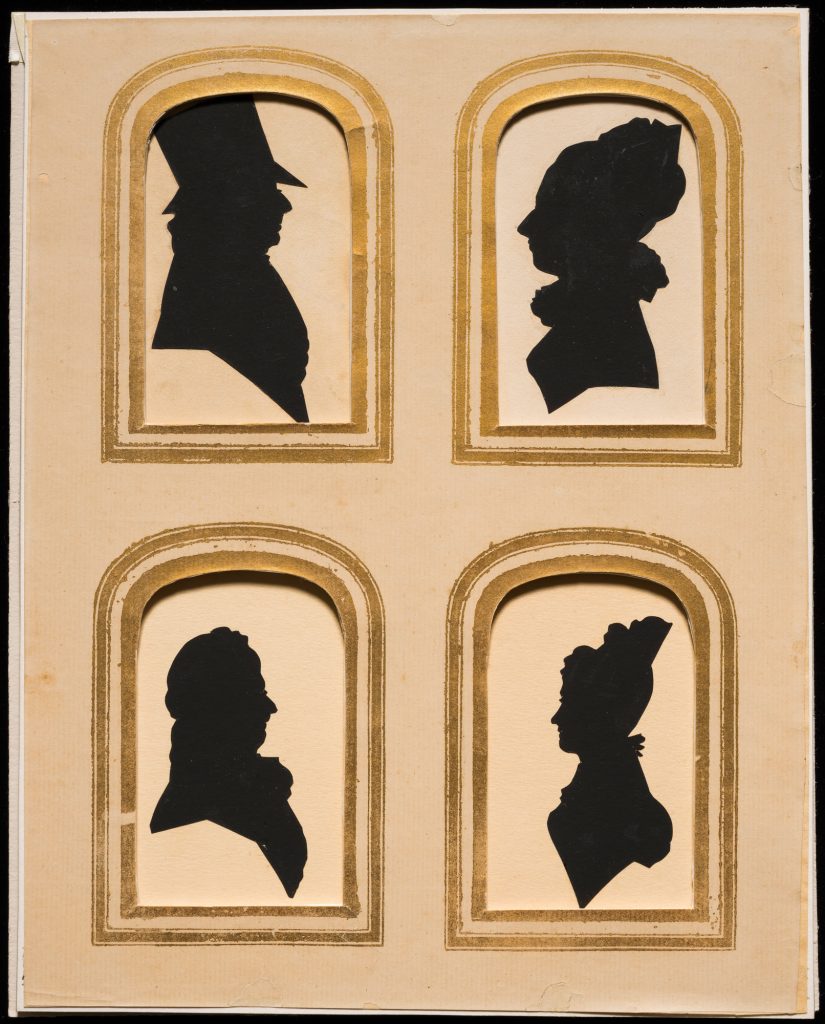Depicted in this silhouette suite are four members of the famed Gratz family of Philadelphia: moving clockwise from top left, they are Benjamin Gratz, his wife, Anna Marie, Rebecca, and Hayman. Benjamin, Rebecca and Hyman were three of the twelve children born to Miriam Simon and Michael Gratz. They were raised in an atmosphere that fostered learning and artistic taste, as well as patriotism, civic engagement and communal pride.
Oldest of these three, Hyman was educated in Philadelphia public schools. He went into business, from 1798 as wholesale grocer, in partnership with his brother Simon, and later sold insurance. In 1818 he was elected director of the Pennsylvania Company for Insurance on Lives and Granting Annuities, and two decades later became president of the firm.
Like many of his siblings he devoted time and attention to philanthropy: he served on the board of the Pennsylvania Academy of Fine Arts, was one of the managers of the first Jewish Publication Society of America, in the 1840s, and served as treasurer of Congregation Mikveh Israel from 1824 to 1856. In coordination with the Hebrew Education Society of Philadelphia—founded by his Rebecca and Rabbi Isaac Leeser—he established a trust of stocks, bonds, and other property, to create a “a college for the education of Jews residing in the city and county of Philadelphia.” Opened in 1895, Gratz College has since grown to become a liberal arts college in suburban Philadelphia.
Next: the incomparable Rebecca. Miriam Gratz instilled in her daughter a distinctive sense of communal responsibility along with charitable duty to the unfortunate. These qualities became characteristic of Rebecca’s public activities throughout her adult life. Her first endeavor was the non-sectarian Female Association for Relief of Women and Children in Reduced Circumstances, which she helped to found, along with her mother, her sister Richea, and a number of other prominent Philadelphia women, in 1801, when she was just twenty years old. Eighteen years later, she would help found a similar charity for poor Jewish women, the Female Hebrew Benevolent Association, which soon became a model for Jewish charities later established in other communities.
Her particular concern for the education of Jewish children led Rebecca to develop a curriculum for the Jewish Sunday school at Mikveh Israel, based on the pedagogy of the Jewish writer and publisher Isaac Leeser, then hazan at Congregation Mikveh Israel, and the Anglo-Jewish teacher and writer Grace Aguilar, whose work Leeser brought to print in the United States.
While celebrated today for her numerous philanthropic activities, Gratz was equally known in her own time for her uncompromising adherence to Judaism despite her integration into the upper echelons of Philadelphia society and its cosmopolitan literary circles. It was this moral rectitude which led Washington Irving, according to one account, to recommend her to Sir Walter Scott as the model for the character bearing the same name in the latter’s novel Ivanhoe.
Benjamin, the youngest of all the siblings, was educated at the University of Pennsylvania but interrupted his studies to enlist in the militia under General Thomas Cadwalader when war broke out with Britain in 1812. He would transfer to the Pennsylvania Volunteers as a Second Lieutenant under command of Captain John Smith the following year. At the end of the war, he resumed his studies at Penn and was awarded an MA in 1815. Two years later, he was admitted to the Pennsylvania bar, making him one of just a handful of Jewish lawyers in the United States. He also joined a Federalist organization called the Washington Association of Philadelphia and served as vice president of that organization.
On November 24, 1819, Gratz married Maria Cecil Gist, the niece of Kentucky statesman Henry Clay, at Lexington, Kentucky. Gratz manufactured hemp, and soon became one of the leading businessmen in the growing town. His election as trustee of Transylvania University was a clear sign of his growing prominence. He would reside in Kentucky for the remainder of his life and served as a trustee of the university for sixty years. Gratz and Maria Gist had six children—five sons who grew to adulthood and another child who died in infancy. When Maria died in 1841, Gratz took as his second wife Anna Marie Boswell—daughter of Dr. Joseph Boswell and Judith Boswell, of Fayette County, Kentucky—with whom he had two daughters and another son who died in infancy. His legacy in Lexington lives on in Gratz Park, a historic district in Lexington. Mount Hope, the home that Gratz purchased for his family in 1824, still stands in this neighborhood, at 231 North Mill Street, facing the park.
